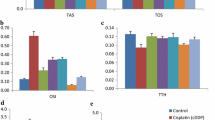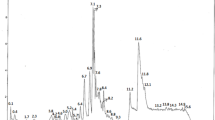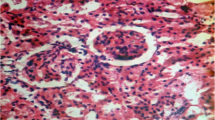Abstract
The aim of this work was to study the nephroprotective role and antioxidant capacity of Atriplex halimus aqueous leaves extract (AHAE) against carbon tetrachloride-induced kidney injury in rats. The experimental rats were randomized into four experimental groups of eight each: Group (C) served as a control received a normal diet, Group (CCl4) received a normal diet for 4 weeks and then was injected with one dose of 1.0 ml/kg body weight of carbon tetrachloride dissolved in olive oil (v/v) intraperitoneally, Group (AHAE + CCl4) received 200 mg/kg body weight of AHAE for 4 weeks and then was injected with one dose of 1.0 ml/kg body weight of carbon tetrachloride dissolved in olive oil (v/v) intraperitoneally, and Group (AHAE) received 200 mg/kg body weight of AHAE for 4 weeks. The AHAE nephroprotective effect was evaluated histopathologically and biochemically through measuring several indices in plasma, urine, and renal tissue homogenates. The results indicated that intraperitoneally injection of CCl4-induced severe kidney injury associated with oxidative stress by increased malondialdehyde (MDA), advanced oxidation protein product (AOPP), and hydrogen peroxide (H2O2) levels and reduced the antioxidant defense system such as reduced glutathione (GSH), vitamin C (Vit C), superoxide dismutase (SOD), catalase (CAT), glutathione peroxidase (GPx), and glutathione-S-transferase (GST) compared with control group. The pretreatment with AHAE significantly restored the majority of these biochemical parameters to normal levels, as well as improved the histopathological changes compared with CCl4-treated group. The obtained results highlighted the potential use of AHAE as a source of bioactive compounds with pharmacological advantages.



Similar content being viewed by others
Abbreviations
- CCl4 :
-
carbon tetrachloride
- AHAE:
-
Atriplex halimus aqueous extract
- GSH:
-
reduced glutathione
- GPx:
-
glutathione peroxidase
- LPO:
-
lipid peroxidation
- H2O2 :
-
hydrogen peroxide
- MDA:
-
malondialdehyde
- TBA:
-
thiobarbituric acid
- TBARS:
-
TBA reactive substances
- AOPP:
-
advanced oxidation protein product
- SOD:
-
superoxide dismutase
- CAT:
-
catalase
- GST:
-
glutathione-S-transferase
- DNPH:
-
carbonyl group with 2,4-dinitrophenylhydrazine
References
Abou-Hany HO, Atef H, Said E, Elkashef HA, Salem HA (2018) Crocin reverses unilateral renal ischemia reperfusion injury-induced augmentation of oxidative stress and toll like receptor-4 activity. Environmental toxicology and pharmacology, 1-31
Aebi H (1984) Catalase in vitro. Method Enzymol 105:121–126
Akca G, Eren H, Tumkaya L, Mercantepe T, Horsanali MO, Deveci E, Dil E, Yilmaz A (2018) The protective effect of astaxanthin against cisplatin-induced nephrotoxicity in rats. Biomed Pharmacother 100:575–582
Alibakhshi T, Khodayar MJ, Khorsandi L, Rashno M, Zeidooni L (2018) Protective effects of zingerone on oxidative stress and inflammation in cisplatin-induced rat nephrotoxicity. Biomed Pharmacother 105:225–232
Altınkaynak Y, Kural B, Akcan BA, Bodur A, Özer S, Yuluğ E, Munğan S, Kaya C, Örem A (2018) Protective effects of L-theanine against doxorubicin-induced nephrotoxicity in rats. Biomed Pharmacother 108:1524–1534
Anadozie SO, Akinyemi JA, Agunbiade S, Ajiboye BO, Adewale OB (2018) Bryophyllum pinnatum inhibits arginase II activity and prevents oxidative damage occasioned by carbon tetrachloride (CCl4) in rats. Biomed Pharmacother 101:8–13
Asada K, Takahashi M, Nagat M (1974) Assay and inhibitors of spinach superoxide dismutase. AgricBiolChem 38:471–447
Badreldin Ali BH, Alza'abi M, Ramkumar A, Al-Lawati I, Waly MI, Beegam S, Nemmar A, Brand S, Schupp N (2014) The effect of activated charcoal on adenine-induced chronic renal failure in rats. Food ChemToxicol 65:321–328
Bahashwan S, Memy HH, Hamdy A, Ghobara MM, El-Beshbishy HA, Busati IBS (2015) Crocin mitigates carbon tetrachloride-induced liver toxicityin rats. Journal of Taibah University Medical Sciences 10:140–149
Blois MS (1958) Antioxidant determination by the use of stable free radical. Nature 26:199–200
Bourmita Y, Belboukhari N, Cheriti A, Ould El Hadj MD (2013) Recherche préliminaire des sources végétales sahariennes à alcaloïdes pour usage bio-insecticides. Algerian journal of arid environment 3:98–102
Bradford M (1976) A rapid and sensitive method for the quantities of microgram quantities of protein utilizing the principal of protein binding. Anal Biochem 72:248–254
Buege JA, Aust SD (1984) Microsomal lipid peroxidation. Method Enzymol 105:302–310
Bulle S, Reddy VD, Hebbani AV, Padmavathi P, Challa C, Puvvada PK, Repalle E, Nayakanti D, Aluganti Narasimhulu C, Nallanchakravarthula V (2016) Nephro-protective action of P. santalinus against alcohol-induced biochemical alterations and oxidative damage in rats. Biomed Pharmacother 84:740–746
Chikhi I, Allali H, Dib MA, Medjdoub H, Tabti B (2014) Antidiabetic activity of aqueous leaf extract of Atriplex halimus L. (Chenopodiaceae) in streptozotocin-induced diabetic rats. Asian Pac J Trop Dis 4:181–184
De Almeida CLB, Cechinel-Filho V, Boeing T, Mariano LNB, Silva LMD, Andrade SF, de Souza P (2018) Prolonged diuretic and saluretic effect of nothofagin isolated from Leandra dasytricha (a. gray) Cogn. Leaves in normotensive and hypertensive rats: role of antioxidant system and renal protection. Chem Biol Interact 279:227–233
De Menezes Peixoto CR, Fraga S, Justim JDR, Gomes MS, Carvalho DG, Jarenkow JA, de Moura NF (2017) Voltammetric determination of total antioxidant capacity of Bunchosia glandulifera tree extracts. J Electroanal Chem, 1–29
El-Ashmawy NE, Khedr NF, El-Bahrawy HA, Helal SA (2018) Upregulation of PPAR-γ mediates the renoprotective effect of omega-3 PUFA and ferulic acid in gentamicin-intoxicated rats. Biomed Pharmacother 99:504–510
Ellman GL (1959) Tissue sulfhydryl groups. Arch BiochemiBiophys 82:70–77
Farooqui Z, Ahmed F, Rizwan S, Shahid F, Khan AA, Khan F (2017) Protective effect of Nigella sativa oil on cisplatin induced nephrotoxicity and oxidative damage in rat kidney. Biomed Pharmacother 85:7–15
Ferreira D, Pinto DCGA, Silva H, Girol AP, de Lourdes Pereira M (2018) Salicornia ramosissima J. woods seeds affected the normal regenerative function on carbon tetrachloride-induced liver and kidney injury. Biomed Pharmacother 107:283–291
Flohe L, Gunzler WA (1984) Analysis of glutathione peroxidase. Method Enzymol 105:114–121
Friday U, Chinedu I, Glory IN (2015) Effect of exposure of male albino rats to kerosene, diesel and petrol on kidney function. International Research Journal of Environment Sciences 4:12–18
Habig WJ, Pabst MJ, Jacoby WB (1974) Glutathione S-transferase, the first enzymatic step in mercapturic acid formation. J BiolChem 249:7130–7139
Hamed H, Gargouri M, Boulila S, Chaari F, Ghrab F, Kallel R, Ghannoudi Z, Boudawara T, Chaabouni S, Feki AE, Gargouri A (2018) Fermented camel milk prevents carbon tetrachloride induced acute injury in kidney of mice. J Dairy Res 85:251–256
Jollow DJ, Mitchell JR, Zamppaglione Z et al (1974) Bromobenzene induced liver necrosis. Protective role of glutathione and evidence for 3, 4-bromobenzene oxide as the hepatotoxic metabolites. Pharmacology 11:51–157
JulkunenTitto R (1985) Phenolics constituents in the leaves of northern willows: methods for the analysis of certain phenolics. J Agric Food Chem 33:213–217
Kooti W, Hasanzadeh-Noohi Z, Sharafi-Ahvazi N, Asadi-Samani M, Ashtary-Larky D (2016) Phytochemistry, pharmacology, and therapeutic uses of black seed (Nigella sativa). Chin J Nat Med 14:0732–0745
Kuatsienu LE, Ansah C, Adinortey MB (2017) Toxicological evaluation and protective effect of ethanolic leaf extract of Launaea taraxacifolia on gentamicin induced rat kidney injury. Asian Pac J Trop Biomed 7:640–646
Kumar M, Dahiya V, Kasala ER, Bodduluru LN, Lahkar M (2017) The renoprotective activity of hesperetin in cisplatin induced nephrotoxicity in rats: molecular and biochemical evidence. Biomed Pharmacother 89:1207–1215
Makni M, Chtourou Y, Fetoui H, Garoui EM, Boudawara T, Zeghal N (2011) Evaluation of the antioxidant, anti-inflammatory and hepatoprotective properties of vanillin in carbon tetrachloride treated rats. Eur J Pharmacol 668:133–139
Mbarki S, Alimi H, Bouzenna H, Elfeki A, Hfaiedh N (2017) Phytochemical study and protective effect of Trigonella foenumgraecum (fenugreek seeds) against carbon tetrachloride-induced toxicity in liver and kidney of male rat. Biomed Pharmacother 88:19–26
Mejri H, Tir M, Feriani A, Ghazouani L, Allagui MS, Saidani-Tounsi M (2017) Does Eryngium maritimum seeds extract protect against CCl4 and cisplatin induced toxicity in rats: preliminary phytochemical screening and assessment of its in vitro and in vivo antioxidant activity and antifibrotic effect. J Funct Foods 37:363–372
Mesnoua M, Mateos-Naranjo E, Barcia-Piedras JM, Pérez-Romero JA, Lotmani B, Redondo-Gómez S (2016) Physiological and biochemical mechanisms preventing cd-toxicity in the hyperaccumulator Atriplex halimus L. Plant Physiol Biochem 106:30–38
Missoun F, Slimani M, Aoues A (2010) Toxic effect of lead on kidney function in rat Wistar. Afr J Biochem Res 4:21–27
Nader MA, Attia GM (2016) Beneficial effects of nilotinib, tyrosine kinase inhibitor on cyclosporine-a induced renal damage in rats. Int Immunopharmacol 33:1–7
Oyaizu M (1986) Studies on product of browning reaction prepared from glucose amine. Jpn J Nutr 44:307–315
Pourmorad F, Hosseinimehr SJ, Shahabimajd N (2006) Antioxidant activity, phenol and flavonoid contents of some selected Iranian medicinal plants. Afr J Biotechnol 5:1142–1145
Prieto P, Pineda M, Anguilar M (1999) Spectrophotometric quantitation of antioxidant capacity through the formation of a Phosphomolybdenum complex: specific application to the determination of vitamin E. Anal Biochem 269:337–341
Rajamani K, Anantharaman P, Chidambaram N, Balasubramanian T, Somasundaram ST (2012) Padina boergessenii ameliorates carbon tetrachloride induced nephrotoxicity in Wistar rats. Journal of King Saud University – Science 24:227–232
Rjeibia I, Feriani A, Ben Saad A, Ncib S, Sdayria J, Saidi I, Souid S, Hfaiedh N, Allagui MS (2017) Phytochemical characterization and bioactivity of Lyciumeuropaeum: a focus on antioxidant, antinociceptive, hepatoprotective and nephroprotective effects. Biomed Pharmacother 95:1441–1450
Roe KM, Kuether CA (1943) Detection of ascorbic acid in whole blood and urine through 2, 4 DNPH derivative of dehydro ascorbic acid. J BiolChem 147:399–407
Safhi MM (2018) Nephroprotective effect of Zingerone against CCl4-induced renal toxicity in Swiss albino mice: molecular mechanism. Oxidative medicine and cellular longevity, 1-7
Sahar SDS, Azza AM, Nepveu F, Valentin A, Roques C (2015) Phenolic composition and prospective anti-infectious properties of Atriplex lindleyi. Asian Pac J Trop Dis 5(10):786–791
Slama K, Boumendjel M, Taibi T, Boumendjel A, Messarah M (2019) Atriplex halimus aqueous extract abrogates carbon tetrachloride-induced hepatotoxicity by modulating biochemical and histological changes in rats. Arch Physiol Biochem 126:49–60. https://doi.org/10.1080/13813455.2018.1489852
Venugopala RK, Arunachalam R, Eerike M, Rao KR, Radhakrishnan AK, Raghuraman LP, Meti V, Devi S (2016) Nephroprotective effect of ethanolic extract of Azimatetracantha root in glycerol induced acute renal failure in Wistar albino rats. J Tradit Complement Med 6:347–354
Walker DJ, Lutts S, Sánchez-García M, Correal E (2014) Atriplex halimus L.: its biology and uses. J Arid Environ 100-101:111–121
Witko-Sarsat V, Friedlander M, Capeillère-Blandin C, Nguyen-Khoa T, Nguyen AT, Zingraff J, Jungers P, Descamps-Latscha B (1996) Advanced oxidation protein products as a novel marker of oxidative stress in uremia. Kidney Int 49:1304–1313
Wolfe K, Wu X, Liu RV (2003) Antioxidant activity of apple peals. J. Agric. Food Chem 51:609–614
Wolff SP (1994) Ferrous ion oxidation in presence of ferric ion indicator xylenol orange for measurement of hydroperoxides. Methods Enzymol 233:182–189
Yilmaz-Ozden T, Can A, Karatug A, Pala-Kara Z, Okyar A, Bolkent S (2014) Carbon tetrachloride-induced kidney damage and protective effect of Amaranthus lividus L. in rats. Toxicol Ind Health 1–11
Zariyantey A et al (2012) Nephroprotective effects of Zingiber zerumbet smith ethyl acetate extract against paracetamol-induced nephrotoxicity and oxidative stress in rats. Biomed & Biotechnol 13(3):176–185
Zhu X, Jiang X, Li A, Zhao Z, Li S (2017) S-Allylmercaptocysteine attenuates Cisplatin-induced nephrotoxicity through suppression of apoptosis, oxidative stress, and inflammation. Nutrients 9(166):1–16
Acknowledgments
The present work was supported by DG-RSDT (General Directorate of Scientific Research and Technological Development- Algeria) via the Laboratory of Biochemistry and Environmental Toxicology, Faculty of Sciences, University of Badji Mokhtar-Annaba, Algeria. The authors are grateful to Chefrour Azzedine, Botany professor at the Faculty of Natural Sciences and the Life (Mohamed Cherif Messaadia University-Souk Ahras, Algeria) for the identification of the plant.
Author information
Authors and Affiliations
Corresponding author
Ethics declarations
Declaration of interest
The authors declare that there is no conflict of interest.
Additional information
Publisher’s note
Springer Nature remains neutral with regard to jurisdictional claims in published maps and institutional affiliations.
Rights and permissions
About this article
Cite this article
Slama, K., Rouag, M., Tichati, L. et al. Nephroprotective role and antioxidant capacity of Atriplex halimus on carbon tetrachloride-induced kidney damage in rats. Comp Clin Pathol 30, 75–87 (2021). https://doi.org/10.1007/s00580-021-03195-3
Received:
Accepted:
Published:
Issue Date:
DOI: https://doi.org/10.1007/s00580-021-03195-3




